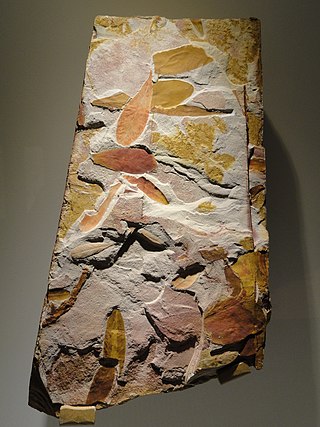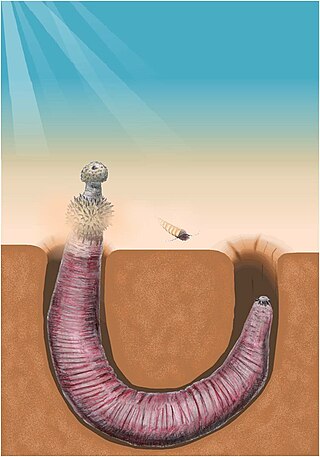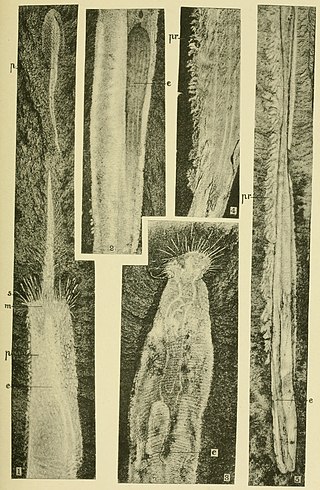
The Cambrian is the first geological period of the Paleozoic Era, and the Phanerozoic Eon. The Cambrian lasted 53.4 million years from the end of the preceding Ediacaran period 538.8 Ma to the beginning of the Ordovician Period 485.4 Ma.

The Ordovician is a geologic period and system, the second of six periods of the Paleozoic Era. The Ordovician spans 41.6 million years from the end of the Cambrian Period 485.4 Ma to the start of the Silurian Period 443.8 Ma.

Chiniquodon is an extinct genus of carnivorous cynodonts, which lived during the Late Triassic (Carnian) in South America and Africa. Chiniquodon was closely related to the genus Aleodon, and close to the ancestry of mammals.
Markuelia is a genus of fossil worm-like bilaterian animals allied to Ecdysozoa and known from strata of Lower Cambrian to Lower Ordovician age containing five species.

Glossopteris is the largest and best-known genus of the extinct Permian order of seed plants known as Glossopteridales. The name Glossopteris refers only to leaves, within the framework of form genera used in paleobotany.

Neuquenraptor is a genus of dromaeosaurid theropod dinosaurs that lived in South America during the Late Cretaceous in what is now the Portezuelo Formation of Argentina. It is one of the first dromaeosaurids found in the Southern Hemisphere.

Cretoperipatus burmiticus is an extinct species of velvet worm that is known from the Burmese amber in Kachin state of Myanmar, originating from the Cenomanian-Turonian stages of the Late Cretaceous.

The Emu Bay Shale is a geological formation in Emu Bay, South Australia, containing a major Konservat-Lagerstätte. It is one of two in the world containing Redlichiidan trilobites. The Emu Bay Shale is dated as Cambrian Series 2, Stage 4, correlated with the upper Botomian Stage of the Lower Cambrian.
The Andaman worm snake is a species of harmless blind snake in the family Gerrhopilidae. The species is endemic to the Andaman Islands. No subspecies are currently recognized.
A number of assemblages bear fossil assemblages similar in character to that of the Burgess Shale. While many are also preserved in a similar fashion to the Burgess Shale, the term "Burgess Shale-type fauna" covers assemblages based on taxonomic criteria only.

Archaeopriapulida is a group of priapulid worms known from Cambrian lagerstätte. The group is closely related to, and very similar to, the modern Priapulids. It is unclear whether it is mono- or polyphyletic. Despite a remarkable morphological similarity to their modern cousins, they fall outside of the priapulid crown group, which is not unambiguously represented in the fossil record until the Carboniferous. In addition to well-preserved body fossils, remains of several archaeopriapulid taxa are known to have been preserved primarily as organic microfossils, such as isolated scalids and pharyngeal teeth. They are probably closely related or paraphyletic to the palaeoscolecids; the relationship between these basal worms is somewhat unresolved.

The palaeoscolecids are a group of extinct ecdysozoan worms resembling armoured priapulids. They are known from the Lower Cambrian to the lower Ludfordian ; they are mainly found as disarticulated sclerites, but are also preserved in many of the Cambrian lagerstätten. They take their name from the typifying genus Palaeoscolex. Other genera include Cricocosmia from the Lower Cambrian Chengjiang biota. Their taxonomic affinities within Ecdysozoa have been the subject of debate.

Cricocosmia is a genus of palaeoscolecid worm from the Early Cambrian Chengjiang biota.

Louisella is a genus of worm known from the Middle Cambrian Burgess Shale. It was originally described by Charles Walcott in 1911 as a holothurian echinoderm, and represents a senior synonym of Miskoia, which was originally described as an annelid. 48 specimens of Louisella are known from the Greater Phyllopod bed, where they comprise < 0.1% of the community. It has been stated to have palaeoscolecid-like sclerites, though this is not in fact the case.

The Fezouata Formation or Fezouata Shale is a geological formation in Morocco which dates to the Early Ordovician. It was deposited in a marine environment, and is known for its exceptionally preserved fossils, filling an important preservational window beyond the earlier and more common Cambrian Burgess shale-type deposits. The fauna of this geological unit is often described as the Fezouata biota, and the particular strata within the formation which exhibit exceptional preservation are generally termed the Fezouata Lagerstätte.
Scolecofurca is a genus of stem-group priapulid worm dating from the Middle Cambrian period approximately 505 million years ago.
Tabelliscolex is a genus of palaeoscolecid worm from the Early Cambrian Chengjiang biota that comprises two species, T. hexagonus and T. maanshanensis.
Titanogomphodon is an extinct genus of diademodontid cynodonts from the Middle Triassic Omingonde Formation of Namibia. It is known from a single partial skull that was described in 1973 from the Omingonde Formation. The type and only species is Titanogomphodon crassus. At about 40 centimetres (16 in), the skull of Titanogomphodon was significantly larger than that of its closest relative, Diademodon. Its teeth are similar to those of another group of cynodonts called Traversodontidae, but the similarities are likely the result of convergent evolution. Aside from its larger size, Titanogomphodon differs from Diademodon in having a bony projection on the postorbital bar behind the eye socket.

Scathascolex is a genus of palaeoscolecid worm known from the middle Cambrian Burgess Shale. It is the only taxon in that famous locality to exhibit the phosphatic plates that characterize palaeoscolecids, and has certain unusual characteristics – it does not have the multiple sizes of tessellating plates more typical of palaeoscolecids, and has more tail hooks than is the norm. Nevertheless, it is clearly a close relative of Palaeoscolex and Wronascolex.













